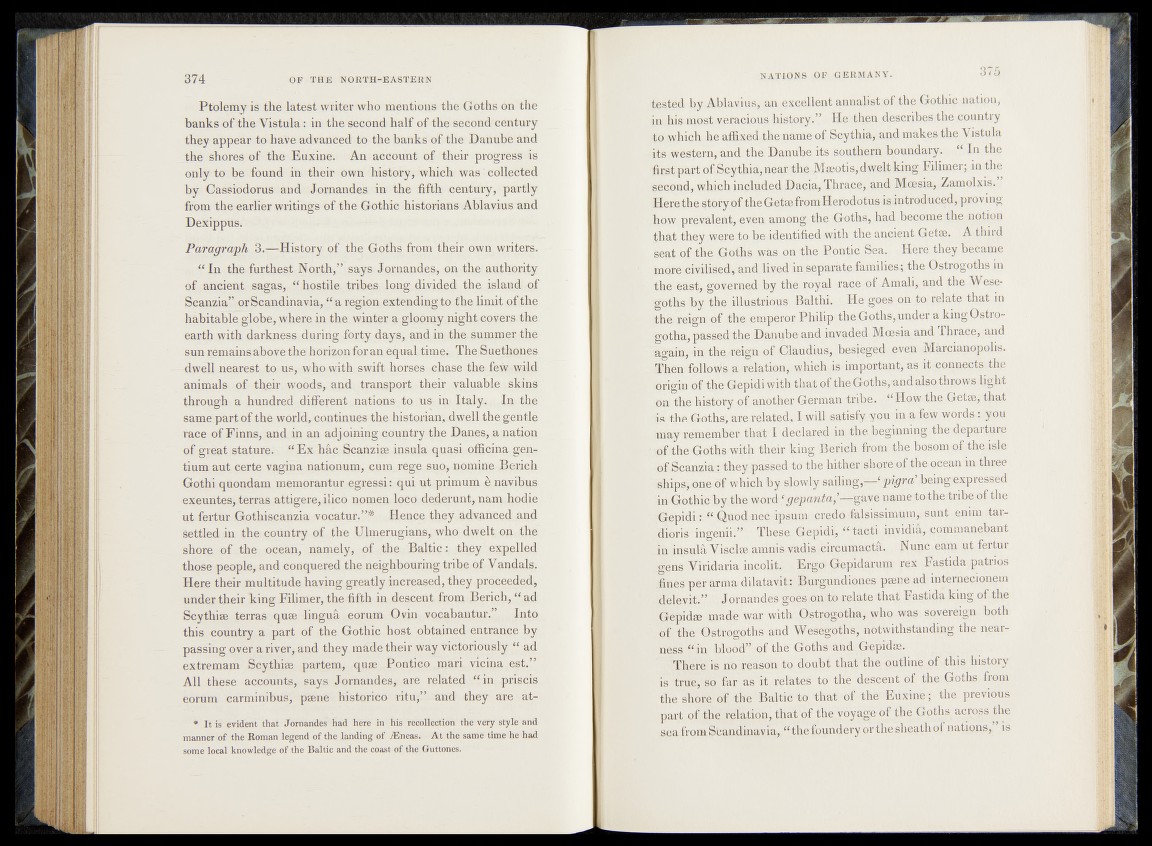
Ptolemy is the latest writer who*-mentions- the1 Goths oh the
banks of the V istula: in the second half of the second century
they appear to-b ave advanced-to the banks of the Danube and
the shores of the Eüxine; An aeeödnfc o f their progress is
only to be found in their own history, which was collected
by Cassiodorus rand Jomandes in the fifth century, partly
from the earlier writings of the Gothic historians Ablavius and
Dexippus.
Paragraph S.-j-JHistory of the Goths from their own^wyile ^ . '
“ In the furthest North,’’ says Jornandes, on the authority
of ancient sagas, “ hostile tribes, long divided the,, island of
Scanzia”, or Scandinavia, “ a region extending to the limit of the
habitable globe, where in the winter a gloomy night covers the
earth with darkness ,during forty days* and in, the., snmmer «the
sun remains above the horizon for an equal timeg;Th%Suethones
dwell nearest to us, who with swift horses, ehase the.i,fpwbwild
animals of their wpods^ljid transport their , valuable skins
through a hundred different nations to j n Italy. In thp
same part of the world, continues the historian, dwell the’gigotle
race of Finns, and in an adjoining c.quntry the Danes, a®atigjt
of great istature. Ex hfic Scanzise insula quasi, offiqin^gefe
tium au t eerte v ^ n a nationum, cur%jfge,;Suq* nomine.JB^peh
Gothi quondam memorantur egressi: qui ut primum j^pavibfis
exeuntes, terras attigere,ilico nomen loco.dpderunf, nam.Jhodie
ut fertur Gotbiscanzia vocatur.”* Henne thpy' adduced,a^d
settled in the-country of the IJJmeragians, who dwelt on^fjfl^
shore of the o&tmf namely, p f the B a ltijp .^ l^ y ^ p p lle d
those people, and conquered the neighbouring tribe of Vandafs.
Here their multitude haying greatly jper-pased, they proceeded»
under their king Pilimer, the fifth in descent from Berich, “ ad
Scythise terras qua? lrogufi .e.orum O vin vocabautur.” Into
this country a part of the Gothic host obtained entrance by
passing over a river, and they made their .way victoriously “ ad
extremam Scythia? partem, quae Pontiop^rn ari vicina est.”
All these accounts, says Jornandes, are related “ in priscis
eorum carminibus, pane historico *ku£’ -and they are at-
* I t is evident that Jornandes fiad hëre in his recollection the very style and
manner of thè Roman legend of the landing of ,®neas. At the same time he had
some local knowledge of the Baltic and the coast-of the Guttones.
tested by Ablavius^ an excellent annalist of the Gothic nation,
in his mpslw^racious history.’’ He then describes the country
-to-which he affi.xed, thepame of,Scyjthia, and makes the Vistula
.its-western, and the Danube* southern boundary. “ In the
firs^part ofgSj&y tfiia, near th e ^ ip p tis, dwelt king Pilimer; in the
^econdT which included; Da,cia,,Thrace^ and Mcesia* Zamolxis-
Herethe story qf.the from Herodotus is introduced, proving
how prevalent, eyjen ampngi* thq.f^pths; had becpme the notion
that they^were tofeppdpntified with the. ancient Getse. A third
Seat of thei,®ijs,was on the RoitldSeib Herdthey became
more,civilised, and liyed in.separate.famiiiespthe. Ostrogoths in
the east-, governed'by the, royal* race-of Amali, and the Wese-
fgoth'S bty the illustrious; Balthi.. He gees, Qn? ta/relate that in
the^reign of thd-hmpeipr Philip thef^pths*, under a kixigOstro-
^sgotha, passed'tpe Danube"apdpnvaded Mossi^and Thrace, and
“a-gairi, in’ th^eignioff-Glaudius, besjegfd^eye'naVlarcianopolis.
•|FMe4fbil^wS.Relation, ^ e h - i s important, as^it connects, the
Origin ^ th eG o p id l^ ith ^ h a tn ith o ^ q f ^ ’and also throws ligh t
-on5 the history of anotherGerqiau tri^ePv/lHow the Getse, that
'is';thor#oths, ate related, I w ill^tisfyypu in a fewAyords: you
may «remember that I declared in the beginning the departure
' ’of the Goths.wjjtjx tf/eir king B e# ich |^ ^ ft|i^ ^ som 'o ffth e isle
5 ^^Spanzm-i they passed to hither-|sh-©.re-of thepcepn in three
ships’,,one Of' which by jsjpvvly sajhng|||£ffpi$r® being expressed
•irtGothic by the Word ƒ gepantay n am© £o the tribe of the
pGepidb: “ Quod needpsujnj cr.&dp falsi^s|mum,!,gpnt. epim tar-
dioris ingdiii?’"' The|e/G|pidi, “ tapti invidih,,pommanebant
in insula ViscJse amnj^^^i^cirpum^th.. Nunc,eam ut fertur
■ .gens Viridaria in-eolith-» Ersot e hpidaruuifJ6^ Fastida patrios
fines perarma dilatayi|| B u rgundiph|s.papeintemecipneto
idelevit.” J Qrpandes ’§h,es^o,n^o relate that,-Fastida .king pf the
Gepidae made war with^sstyogotha, who w.as sovereign both
,pf the Gsttogoths und Wpg%#|^$>twithstandi|ig the nearness
“ in hlood’hpf the Gpths,-aiid Jpcpidae.
There isihp.reason to 'dpubt that the- putline pf this history
is tr\ae/sP.far a £ it m k ^ dW |h e descent of the'Goths from
the shore of the Baltic to th a t1 of the Euxine;' the previous
part of the relation, that pf thjjeyilge of the (xoths across the
.sea from Scandinavia,. “ the foundery or the sheath of nations, is